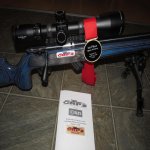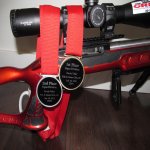On the design point, no not necessarily just a lot to lot issue. If the design of the bullet does not like going below a certain speed or spin rate it begin to yaw. Not a whole lot of research has been done on rimfire beyond day 100 yards that I know of. Maybe we have not seen certain elements as of yet. Compare this to centre fire for a minute. Flat base bullets perform very well up to say 300 yards, but I have yet to see a flat base long range suitable projectile at a match. The boat rail performs better at long range (well documented).
You yourself have stated that we are a small market and rimfire manufacturers don’t really see It as being worth it to improve. (Not word for word quote). Then why is it hard to believe there is something else going on as a bullet makes its way down range. I have always had the most success going with lapua or sk at range, their bullets have a definite design difference than eley for example. This leads me to believe their design (which has a higher B.C.) is better suited for my needs. If you are just shooting 57 yards these differences don’t show up yet as the bullet has not slowed down, changed drag model or whatever has changed.
If I have my speed and bc correct and I can make impact on targets all the way from 50 yards to 250 yards then all of a sudden becomes incredibly inconsistent with one bullet and have great success with another can you explain. If I can do with one and not the other it is not me, done on the same day it won’t be temperature or conditions.
Maybe we just don’t know something as of yet with the little projectile wandering down range at a slow speed and low spin rate.
Maybe just maybe Jerry or the people who make some damn fine centre fire bullets will figure something out that the rimfire companies haven’t bothered to look for as (we are a small market and it isn’t worth changing their molds or whatever you mentioned). The 22 elr is new and we are just starting to see companies cater to it. I have seen a few videos that are very compelling on the sk long range round that back this up. Maybe we will see some neat stuff coming down the pipe, maybe not. I have seen some rounds degrade as they travel, try it you might see the same,
So I have shown you that my Bergara shot eley tenex to .1 at 50 1.25 at 100. Sk rifle match could only muster .25 at 50 but held a sub 1 inch group at 100, so not ipso facto the bullet that performed better at 50 did not perform better at 100, wether it is design or speed, spin, I don’t know. Can you explain. Please don’t say shooter, that’s why I did 20 round groups. Same day same environment, same technique.
Please explain for me so I know as well
You're arguing that poorly understood, ill- defined force(s) act on some bullets but not on others. And as long as it's a mystery, we just have to accept that somehow those selective forces exist. They simply do not affect some ammo but negatively impact other ammos even when they have performed very well out to 100 yards.
That's an interesting point of view. As long as it doesn't require any proof, you can believe it.
It seems a little desperate to cling to the hope that someone or some business more attuned to centerfire bullets and centerfire shooting will come to the rescue of .22LR shooting and "will figure something out that the rimfire companies haven’t bothered to look for." The manufacturers of .22LR match ammo make ammo as good as can be made with current technology. The .22LR has limits as to what it can do. That's a fact of life, despite enthusiasms expressed in this thread and elsewhere in this forum about "solutions" to long distance shooting.
If anyone wants to get better ammo, it's available. It's been available for decades. It's arguably technologically more advanced now, that is taking advantage of the most recent scientific developments, than ever before. The catch is that it requires buying ammo that typically costs much more than what probably most long range shooters are willing to pay. But it's not just money. Shooters looking for the most accurate ammo for their .22LR will have to lot test to find which lots shoot best in their rifles. And perhaps it is all for naught if shooters' rifles are often not up to the job of making the most out of the best ammo.
To address one of the specific points you've made. You said "I have shown you that my Bergara shot eley tenex to .1 at 50 1.25 at 100. Sk rifle match could only muster .25 at 50 but held a sub 1 inch group at 100, so not ipso facto the bullet that performed better at 50 did not perform better at 100, wether it is design or speed, spin, I don’t know. Can you explain."
I'll offer an explanation, but please don't be offended by it. That's not my purpose. My guess is that you didn't shoot Tenex
consistently at .1" at 50 yards. That is, if you shot more than one most of your ten-shot-groups didn't measure .1" although perhaps one or two did. If you shot a whole lot of them, I suspect it would be more well known considering the level of achievement represents. This is how you described it on your Bergara thread: "Well I am amazed, 1 inch 20 shot group with sk rifle match at 100, in the .1 area with tenex at 50 10 shot group and only about a brick through the gun".
Shooting one very good group itself is only enough to say it could be the result of a random chance of accuracy. Furthermore, shooting .25" with SK RM is very good indeed -- again if it's done consistently. The corollary to this is that it's not reasonable to expect one or only two very good groups to translate into similarly good groups at twice the distance.
With regard to the SK RM, any time you shoot a 20 shot group with a .22LR at 100 yards and it's under 1" the target should be preserved like a treasured document. It represents very, very good results, no matter what the ammo, what the rifle. Consistently sub-MOA five shot groups at 100 are good enough that 20 shot groups that are one inch should be considered extraordinary. I would submit that your search for long range .22LR ammo has been very successful indeed.
To be fair and consistent with regard to my remarks about the Tenex ammo you shot, however, I have to ask was this 20 shot one inch group repeated? Results that are not repeatable are not representative of consistent shooting or consistent results. A more fair and reliable method of comparing ammo is by shooting five 5 or 10-shot groups at both 50 yards and 100 yards, under the same conditions, and then compare the results. This will give a more complete and dependable set of results on which to draw conclusions. It's a mistake to judge any shooting or ammo on the basis of too little information.
I hope I have made some sense. If my assumptions are in error, I'll apologize in advance and welcome correction.
What is really important here is the knowledge of what round will do, not necessarily making sure the group is the smallest possible. Don't get me wrong. Smaller groups will still result in better scores.... But solid knowledge about real world results will earn you far more hits.
I have no doubt that if I was shooting bullseyes for score at 200 yards then your comments and experience would prove to be more valuable.
What's even more important is the understanding that accuracy is accuracy no matter what the distance, no matter what the goal is, whether it's small groups at 50 or 100 yards or striking a 12" or 16" steel plate out at 250 or 300 yards. There's no special knowledge that's valid only beyond 100 yards.
At the same time, it's hard to escape the sense that you are conceding or somehow accepting in some degree to the idea that pinpoint accuracy is less important in your "real world" of long distance shooting. If you were shooting bullseyes for score (that is for accuracy), then you would find my comments more valuable.
It's an odd admission to say the least.














































































